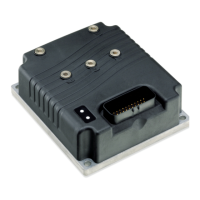80
Curtis 1222 Manual, os 15
2 9 J A N U A R Y 2 0 1 3 D R A F T
“3” — Setup for Sawtooth Sensor input (see page 28)
Note: The steer motor should not respond to this command input because the
Interlock is Off. If the steer motor shows any movement (or if the Interlock is
On), stop and resolve the issue; see Preparation for commissioning, page 74.
a. Set the parameters Min Volts and Max Volts according to the sensor manufacturer’s
specifications. If sensor specs are not available, use the voltages shown in the
Monitor
» Command Input » Analog Input » Analog1 and Analog3 variables as fol-
lows. To get the correct values for
Min Volts and Max Volts, find the highest and low-
est values of
Analog1 and Analog3 while slowly sweeping the command device. In-
put the lowest value as
Min Volts and the highest value as Max Volts. Example: While
the command device is moved slowly,
Analog1 and Analog3 are shown to have
a minimum voltage of 1.9 V and a maximum voltage of 4.1 V; therefore,
Min
Volts = 1.9 V and Max Volts = 4.1 V.
b. Decide if the sensor input will be in absolute position mode or relative posi
-
tion mode, and then follow Step “c” or “d” as appropriate.
Absolute Mode = On is for absolute position mode. The sensor input
typically has a range of motion that matches the range of motion of the
steered wheel (not multi-turn) and the center, right, and left positions are
all defined. Absolute position mode is typically used for walkie and walkie
rider material handling applications.
Absolute Mode = Off is for relative position mode. The sensor input is
typically a multi-turn device with the center position being wherever the sen
-
sor is positioned when the interlock is turned on. Relative position mode is
typically used for reach trucks and man-up material handling applications.
c. For Absolute Position Mode (Absolute Mode = On):
1. Move the Sawtooth Sensor to the center position and observe the
angle shown in the Monitor
» Command Input » Analog Input » Angle
Raw variable. Set the Center Angle to the observed angle. This parameter
must be set before the Left and Right angle parameters are set, because
the center angle is based on the raw reading and normalizes the angle
for setting up the Left and Right angles.
2. Move the Sawtooth Sensor to the Left position (not to the actual
physical stop, but a small amount away, to allow for sensor tolerance
variation) and observe the angle shown in the Monitor
» Command
Input
» Analog Input » Angle variable. If the observed angle was nega-
tive, set the
Left Angle parameter to the observed angle.
If the observed angle was positive, change the parameter
Swap
Direction. Verify that the steer direction sign is correct (-), and then
return to Step “b” to reset the
Center Angle parameter. Finally, set the
Left Angle parameter to the observed angle.
3. Move the Sawtooth Sensor to the Right position (not to the actual
physical stop, but a small amount away, to allow for sensor tolerance
variation) and observe the angle shown in the
Angle variable. Set the
Right Angle parameter to the observed angle.
5 — COMMISSIONING

